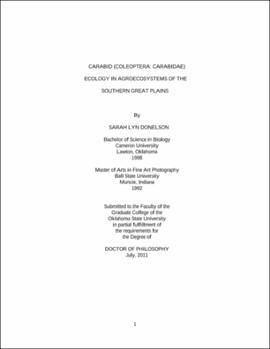| dc.contributor.advisor | Giles, Kristopher L. | |
| dc.contributor.author | Donelson, Sarah Lyn | |
| dc.date.accessioned | 2013-11-26T08:23:44Z | |
| dc.date.available | 2013-11-26T08:23:44Z | |
| dc.date.issued | 2011-07 | |
| dc.identifier.uri | https://hdl.handle.net/11244/6732 | |
| dc.description.abstract | Scope and Method of Study: In the Southern Great Plains, natural enemy assemblages regularly exert biological control in annual crops. These assemblages have a regulating effect on pest populations which can maintain these populations below economic threshold levels. Carabidae constitute a major part of agricultural fauna and are an important part of the natural enemy assemblages regulating pest populations in agroecosystems of this region. Conservation of carabid beetles in agroecosystems is dependent on knowing their biology. However, carabid biology within diverse agricultural systems of the Southern Great Plains is not well studied. These studies were designed to determine the impact of tillage on carabid biology, elucidate carabid dispersal powers in diversified agricultural systems, ascertain natal origins and describe carabid utilization of a semi-permanent crop, alfalfa. | |
| dc.description.abstract | Findings and Conclusions: This study has quantified carabid colonization of an annual crop (sorghum) from a semi-permanent habitat (alfalfa) and small scale colonization was measureable for some carabid genera. No significant differences were detected between no-till and conventional-tillage within years. Tillage effects were detectable at the genus level in this study. This study found evidence that carabids were moving within and among sorghum and alfalfa with some indication of cyclic colonization based upon stable carbon isotope ratios. Isotope data revealed that diet switching between habitats by carabids was evident in both years. This study has demonstrated that natal origins can be inferred from carbon isotopic compositions transferred to carabid adults from larval dietary intake. Natal origins indicated that alfalfa provided carabids with alternate prey, oviposition sites, overwintering habitat, and refuge from farming operations. | |
| dc.format | application/pdf | |
| dc.language | en_US | |
| dc.rights | Copyright is held by the author who has granted the Oklahoma State University Library the non-exclusive right to share this material in its institutional repository. Contact Digital Library Services at lib-dls@okstate.edu or 405-744-9161 for the permission policy on the use, reproduction or distribution of this material. | |
| dc.title | Carabid (Coleoptera: Carabidae) ecology in agroecosystems of the Southern Great Plains | |
| dc.contributor.committeeMember | Mulder, Phillip | |
| dc.contributor.committeeMember | Dillwith, Jack | |
| dc.contributor.committeeMember | Elliott, Norman | |
| dc.contributor.committeeMember | Ewing, Margaret | |
| osu.filename | Donelson_okstate_0664D_11656.pdf | |
| osu.accesstype | Open Access | |
| dc.type.genre | Dissertation | |
| dc.type.material | Text | |
| dc.subject.keywords | carabid | |
| dc.subject.keywords | carabids | |
| dc.subject.keywords | ground beetles | |
| dc.subject.keywords | insect ecology | |
| dc.subject.keywords | isotopes | |
| dc.subject.keywords | tillage | |
| thesis.degree.discipline | Entomology | |
| thesis.degree.grantor | Oklahoma State University | |
